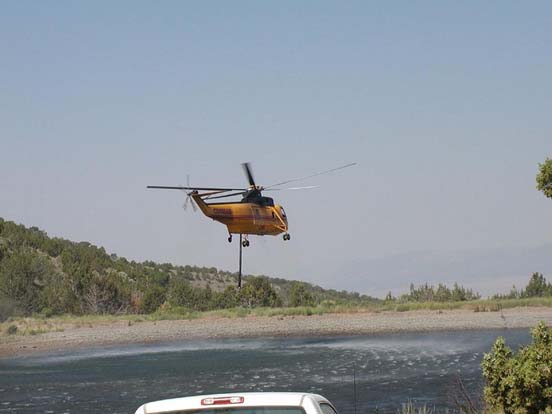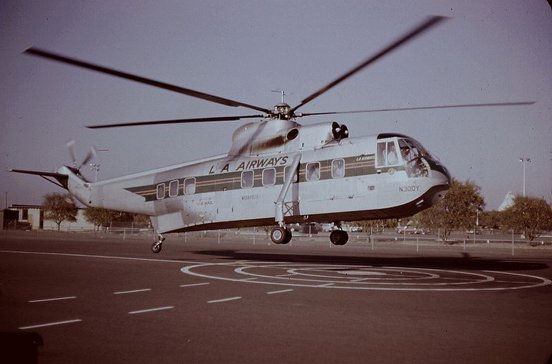 |
|
By
Wikipedia,
the free encyclopedia,
http://en.wikipedia.org/wiki/Sikorsky_S-61L
 | |
An S-61 helitanker uses a snorkel to refill its internal water tanks |
The Sikorsky S-61L and S-61N are civil variants of the successful SH-3 Sea King helicopter. They are two of the most widely used airliner and oil rig support helicopters built.
Design and development
In September 1957, Sikorsky won a United States Navy development contract for an amphibious anti-submarine warfare (ASW) helicopter capable of detecting and attacking submarines. The XHSS-2 Sea King prototype flew on 11 March 1959. Production deliveries of the HSS-2 (later designated SH-3A) began in September 1961, with the initial production aircraft being powered by two 930kW (1250shp) General Electric T58-GE-8B turboshafts.
Sikorsky was quick to develop a commercial model of the Sea King. The S-61L first flew on 2 November 1961, and was 4ft 3in (1.27m) longer than the HSS-2 in order to carry a substantial payload of freight or passengers. Initial production S-61Ls were powered by two 1350shp (1005kW) GE CT58-140 turboshafts, the civil version of the T58. The S-61L features a modified landing gear without float stabilisers.
Los Angeles Airways was the first civil operator of the S-61 introducing them on 11 March 1962, for a purchased price of $650,000 each.
On 7 August 1962, the S-61N made its first flight. Otherwise identical to the S-61L, this version is optimized for overwater operations, particularly oil rig support, by retaining the SH-3's floats. Both the S-61L and S-61N were subsequently updated to Mk II standard with improvements including more powerful CT58-110 engines giving better hot and high performance, vibration damping and other detail refinements.
The Payloader, a stripped down version optimised for aerial crane work, was the third civil model of the S-61. The Payloader features the fixed undercarriage of the S-61L, but with an empty weight almost 2000lb (900kg) less than the standard S-61N.
Carson Helicopters was the first company to shorten a commercial S61. The fuselage is shortened by 50in (1.6m) to increase single engine performance and external payload.
A unique version is the S-61 Shortsky conversion of S-61Ls and Ns by Helipro International. VIH Logging was the launch customer for the HeliPro Shortsky conversion which first flew in February 1996.
One modification for the S-61 is the Carson Composite Main Rotor blade. These blades replace the original Sikorsky metal blades which are prone to fatigue. The Carson Composite Main Rotor blades permit a modified aircraft to carry an additional 2,000 lb (907 kg) load, fly 15 kn (28 km/h) faster and increases range 61 nmi (113 km).
Variants
- S-61L
- Non-amphibious civil transport version. It can seat up to 30 passengers (13 Built).
- S-61L Mk II
- Improved version of the S-61L helicopter, equipped with cargo bins.
- S-61N
- Amphibious civil transport version.
- S-61N Mk II
- Improved version of the S-61N helicopter.
- S-61 Payloader
- Stripped down machine optimised for aerial crane work; features the fixed undercarriage of the S-61L, but with an empty weight almost 900kg (2000lb) less than the standard S-61N.
- S-61 Shortsky
- Shortened conversion of the S-61L and N, designed to increase single engine performance and external payload.
Operators
- Former operators are marked by italics
 Brunei Brunei
 Canada Canada
 Spain Spain
 Greenland Greenland
 Ireland Ireland
 Lebanon Lebanon
 Maldives Maldives
 Netherlands Netherlands
 Pakistan Pakistan
 United Kingdom United Kingdom
 United States United States
Notable accidents
 | |
N300Y, the S-61L prototype, departing from Disneyland Heliport on a flight five years prior to its accident flight. |
- On 22 May 1968, Los Angeles Airways Flight 841 crashed near Paramount, California, resulting in the loss of 23 lives. The accident aircraft, N303Y, serial number 61060, was a Sikorsky 61L en route to Los Angeles International Airport from the Disneyland Heliport in Anaheim, California.
- On 14 August 1968, Los Angeles Airways Flight 417 crashed in Compton, California, while en route to the Disneyland Heliport in Anaheim, California from Los Angeles International Airport, resulting in the loss of 21 lives. The accident aircraft, N300Y, serial number 61031, was the prototype of the Sikorsky S-61L.
- On 16 May 1977, New York Airways' commercial S-61-L, N619PA, suffered a static rollover onto its starboard side at the heliport on top of the Pan Am Building, in Mid-town Manhattan while boarding passengers. The accident killed four people, and seriously injured one person on the ground. 17 additional passengers and the three flight crew members were uninjured. The accident was a result of metal fatigue in the helicopter's main landing gear shock-absorbing strut assembly, which caused the helicopter to tip over without warning. The accident caused the permanent closure of the Pan Am Building heliport.
- On 16 July 1983, British Airways Helicopters' commercial S-61 G-BEON crashed in the southern Celtic Sea, in the Atlantic Ocean, while en route from Penzance to St Mary's, Isles of Scilly in thick fog. Only six of the 26 on board survived. It sparked a review of helicopter safety and was the worst civilian helicopter disaster in the UK until 1986.
- 12 July 1988 a British International Helicopters S-61N ditched into the North Sea, no injuries.
- On 5 August 2008, two pilots and seven firefighters assigned to the Iron Complex fire in California's Shasta-Trinity National Forest, were killed when Carson Helicopters Sikorsky S-61N helicopter N612AZ crashed on take-off. Of the 13 people reported to be on-board, one other pilot and three firefighters survived the crash with serious or critical injuries. Both FAA and National Transportation Safety Board are investigating.
Specifications (S-61N Mk II)
Data from International Directiory of Civil Aircraft
General characteristics
- Crew: 2 pilots
- Capacity: up to 30 passengers
- Length: 58 ft 11 in (17.96 m)
- Rotor diameter: 62 ft (18.9 m)
- Height: 17 ft 6 in (5.32 m)
- Disc area: 3,019 ft² (280.6 m²)
- Empty weight: 12,336 lb (5,595 kg)
- Loaded weight: lb (kg)
- Max takeoff weight: 19,000 lb (8,620 kg)
- Powerplant: 2× General Electric CT58-140 turboshafts, 1,500 shp (1,120 kW) each
Performance
See also
Related development
External links
Text from Wikipedia is available under the Creative Commons Attribution/Share-Alike License; additional terms may apply.
Published in July 2009.
Click here to read more articles related to aviation and space!
|
 |



